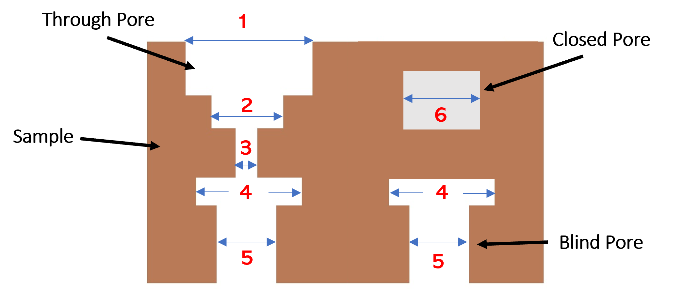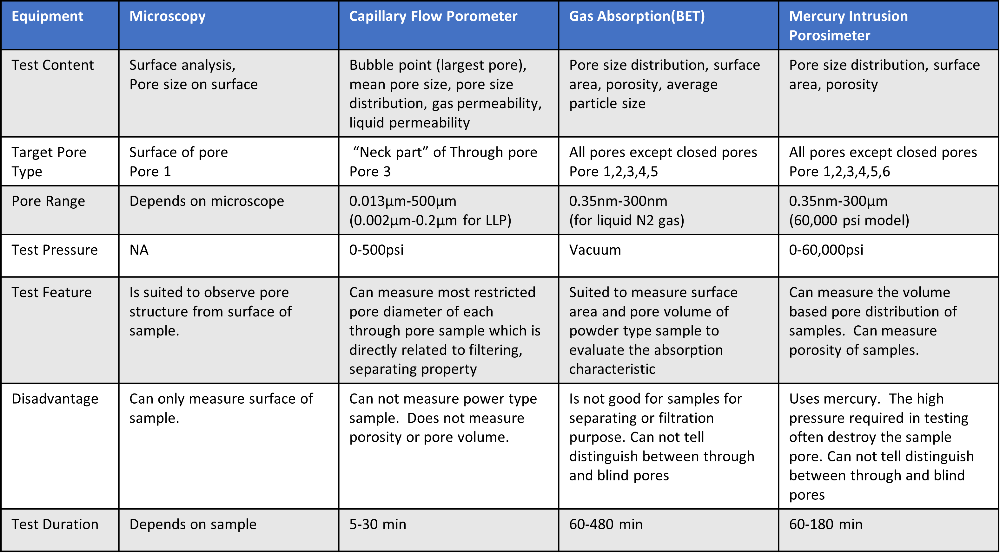Different methods of pore characterization
Porous materials are widely used in various applications such as filtration, separation, catalysis, energy storage, and biomedical engineering. The pore structure of porous materials plays a critical role in determining their performance. Therefore, accurate and reliable measurement of pore size distribution, pore volume, and surface area is essential for optimizing the design and operation of porous materials. In this article, we will discuss the different techniques available for measuring the pore size of porous materials.
Mercury Intrusion Porosimetry (MIP):
MIP is a widely used technique for measuring the pore size distribution and total porosity of macroscopic samples of porous materials. It involves applying increasing pressure to force mercury into the pores of a sample and measuring the volume of mercury intruded at each pressure level. The intrusion volume is related to the pore size using capillary equations. MIP can measure pores ranging from 0.003 to 300 microns i
Gas Adsorption:
Gas adsorption is another commonly used technique for measuring the surface area, pore volume, and pore size distribution of porous materials. It involves exposing a sample to a gas such as nitrogen or argon at different pressures and temperatures and measuring the amount of gas adsorbed onto the sample surface using techniques such as Brunauer-Emmett-Teller (BET) or Langmuir analysis. The amount of gas adsorbed is related to the surface area and pore size using adsorption isotherms.
Capillary Flow Porometry:
The capillary flow porometer employs a unique methodology by utilizing porous samples with its pores saturated with a wetting liquid. Gas pressure is applied from one size of the sample and through careful measurement of gas pressure and the flow rate of gas through the pores, crucial characteristics such as largest pore size (bubble point pore size), pore size distribution, mean pore size, as well as gas permeability are determined by a notable relationship in which the gas pressure to expel the liquid from a pore exhibits an intriguing inverse correlation with the pore diameter of the sample. Additionally, the technique specifically measures the "neck pore" which represents the narrowest diameter within each open pore of the sample. This measurement provides valuable insight into the sample's filtration or separation properties, as the neck pore is the most constricted point along the pore structure.
Scanning Electron Microscopy (SEM):
SEM is a high-resolution imaging technique that can be used to visualize the surface morphology of porous materials at the micro- and nanoscale. SEM can also be used to measure the pore size distribution by analyzing cross-sectional images of the sample. However, SEM cannot provide quantitative information on pore size distribution, pore volume or permeability of the sample as it is a visualization method representing only a very small area of the sample.

Graph1: Different types of pores within a porous material and it pore diameter

Chart1: Difference in the features of each method of porous material
In conclusion, there are several techniques available for measuring the pore size of porous materials, each with its advantages and limitations. The choice of technique depends on factors such as sample type, pore size range, accuracy requirements, cost, and pore characterization needs. A combination of techniques may be necessary to obtain a comprehensive characterization of porous materials for specific applications.